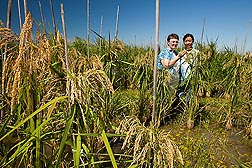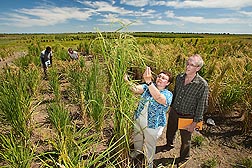Mapping the Way to Even Healthier Rice
With the aid of high-tech tools, Agricultural Research Service and collaborating scientists are closing in on the genes in rice that regulate the uptake and storage of important minerals—a pursuit that could bolster the nutritional value of this cereal grain crop as a staple food for roughly half the world’s population.
Ultimately, the team envisions biofortifying rice using traditional plant breeding methods to develop new varieties whose kernels (grain) boast exceptionally high concentrations of essential minerals, including zinc, iron, and calcium.
Rice is a mainstay of the human diet for good reason. It is a rich source of energy, free of gluten (which causes allergic reactions in some individuals), easy to digest, low in fat, and packed with vitamins, minerals, and other nutrients. Some key elements, however, like iron, are lost when the bran on brown rice is stripped off during milling to produce so-called white rice, notes Shannon Pinson, a plant geneticist with the ARS Dale Bumpers National Rice Research Center in Stuttgart, Arkansas.
“More than 70 percent of the white rice eaten in the United States is ‘enriched,’ meaning that thiamine, niacin, iron, and folic acid have been added to the outside surface of the uncooked white kernels to bring the overall nutritional level up to or higher than that of the whole grain (brown rice) for these vitamins,” write Pinson and coauthors in an article describing their work in the October 2010 issue of the newsletter Texas Rice.
But in developing countries where rice is a mainstay, fortifying the grain after milling may not be a viable option. Additionally, the soils in which the crop is grown may be lacking in certain essential minerals. For populations that rely on rice as a staple food, low levels of iron, zinc, or other minerals can lead to nutritional deficiencies that manifest as fatigue, poor immune system function, and other symptoms. Indeed, more than 3 billion people worldwide suffer from iron or zinc deficiencies in their diets.
To address these concerns, Pinson and her ARS and university colleagues focused their studies on three different groups, or “populations,” of rice—with the most diverse represented by 1,643 lines (called “accessions”) collected from 114 countries around the world. In this diverse group, the researchers encountered rice accessions whose grains contained up to nine times the amount of minerals normally observed in standard U.S. varieties.
“We’ve crossed these accessions with the U.S. cultivar Lemont and are now evaluating the seed of second-generation plants for extreme grain concentrations of these minerals,” says Pinson.
Her chief collaborators are David Salt of the University of Aberdeen, United Kingdom (and adjunct professor at Purdue University); Mary Lou Guerinot of Dartmouth College; Lee Tarpley of Texas A&M AgriLife Research, and Ratnaprabha Chittoori, a graduate student being co-mentored by Pinson and Tarpley.
The group began the project in 2007. The National Science Foundation is supporting the effort, which includes mapping the approximate locale of the genes on rice’s 12 chromosomes and developing marker data to easily detect them during future breeding efforts.
The collection they’re working with, the USDA Core Collection, was developed by Wengui Yan at the USDA-ARS Dale Bumpers National Rice Research Center in Stuttgart, Arkansas, in collaboration with the National Plant Germplasm System’s National Small Grains Collection, which is maintained in Aberdeen, Idaho, by ARS and includes more than 17,000 total rice accessions.
Based on data from side-by-side comparisons conducted under controlled field conditions in Beaumont, Texas, the team identified 40 rice accessions whose grain contained high levels of minerals important not only to human health, but also to that of the rice plant. Take, for example, calcium.
“Calcium strengthens the plant cell wall and decreases permeability of cell membranes, which, in turn, can lead to increased resistance to diseases and environmental stresses,” explains Pinson.
Also of interest are rice accessions with low grain levels of certain elements that are toxic to plants and people, such as arsenic and cadmium. Rice with low levels of arsenic or cadmium may have genes that sequester or bind these toxic minerals in leaves instead of grain or that curtail their absorption from contaminated soils or irrigation water—a concern, for example, in parts of Bangladesh where rice is grown as a staple crop and high arsenic levels in water are indigenous.
In the Beaumont studies, the team compared mineral uptake in rice plants grown in flooded and nonflooded fields. Flooding, Pinson explains, changes the soil chemistry and converts some elements into forms more available for mineral uptake and others into less available forms. By studying plants grown in both soil conditions, the team was able to identify even more genes and to gain knowledge about how the genes function in the plant to affect element uptake and accumulation.
To date, the team has identified 127 genes clustered in 40 different chromosome regions that correlate to high concentrations of particular minerals. They have also identified genes affecting other grain features, including shape, and found that grain element accumulation is largely independent of these other grain quality attributes.
Other findings are that:
- there is a wide range of mineral concentrations among rice accessions from around the world.
- mineral levels fluctuated more when rice was grown in nonflooded fields than in flooded ones.
- rice with the highest grain levels of certain minerals, like molybdenum (important for plant nitrogen nutrition; high levels help rice cope with acidic soils), sometimes originated from the same geographic region of the world.
- natural gene variation may be responsible for some of the highest mineral levels in grain.
- plant maturity influences the amount of mineral absorbed and where it is stored—in leaves, bran, or grain, for example.
The team is also developing molecular marker data to quickly identify high-mineral rice plants without growing them to maturity during breeding operations. There is early evidence that high mineral levels (calcium, for example) in the leaves of seedlings of some rice varieties may correlate with high mineral levels in the grain at maturity. The team is investigating whether root architectural or physiological traits, which are expected to affect rates of mineral uptake from the soil, are causing differences that carry through to differences in grain concentrations. These seedling assays could offer a way for rice breeders to save time and money in selecting top-performing plants for use in developing elite commercial varieties. Much work has yet to be done toward that end, but the stage is set.
In addition to ensuring that consumers get more of the essential minerals needed for their sustained health and well-being, biofortified rice could mean expanded markets for U.S. growers, both domestically and abroad. Lastly, the approach could serve as a useful model for biofortifying other important grains that feed the world.—By Jan Suszkiw, Agricultural Research Service Information Staff.
This research is part of Plant Genetic Resources, Genomics, and Genetic Improvement, an ARS national program (#301) described at www.nps.ars.usda.gov.
Shannon Pinson is in the USDA-ARS Dale Bumpers National Rice Research Center, 2890 Highway 130 East, Stuttgart, AR 72160; (870) 672-9300, ext. 228.
"Mapping the Way to Even Healthier Rice" was published in the May/June 2013 issue of Agricultural Research magazine.









